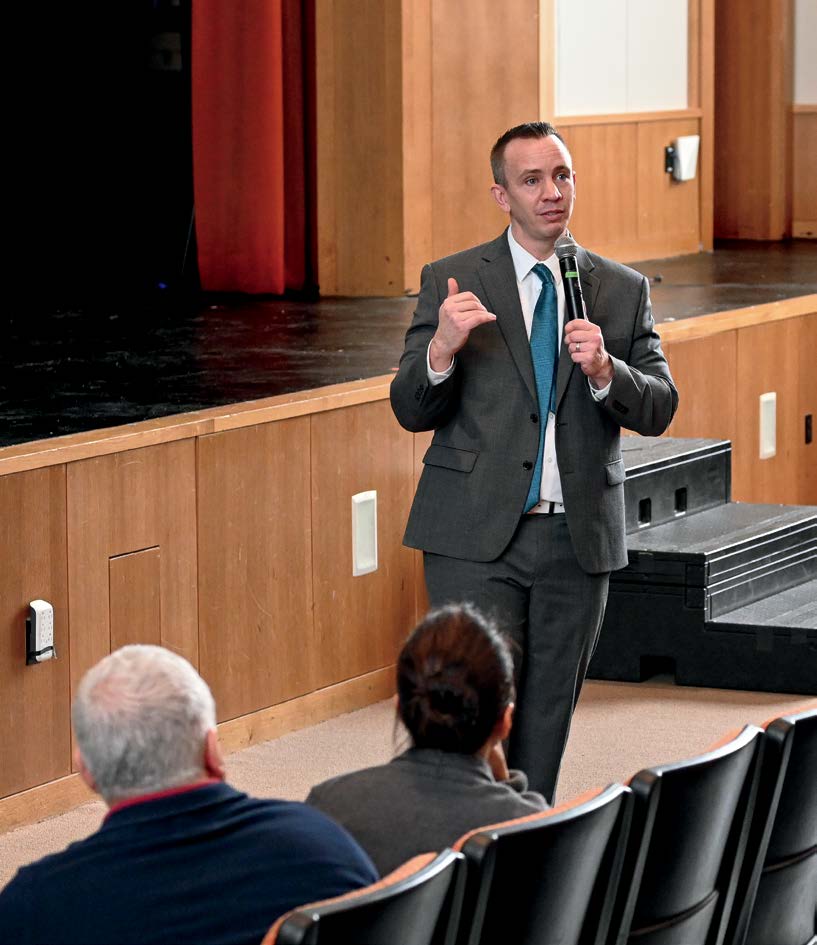
Focusing on Student Centered Learning
GCDS faculty paused their classroom teaching on Feb. 16 for a schoolwide Professional Development Day. The day started with a keynote address by John Spencer, an expert in project-based learning and creativity in the classroom. Mr. Spencer, Associate Professor of Education at George Fox University and former Middle School teacher, along with members of the faculty, also held several workshops throughout the day on similar topics.
“I am on a quest to help teachers unleash the creative potential in all of their students so that kids can be makers, designers, artists, and engineers,” said Mr. Spencer in his opening remarks. “Classrooms should be bastions of wonder.”
Mr. Spencer used research and examples to stress the importance of student-centered learning that values collaboration, risk taking, authentic experiences, iterative thinking, and finding problems as well as solving them. “We have to get our students ready for the creative economy and that requires the chasing of curiosity.”
“Mr. Spencer’s messages are aligned with the GCDS’s Portrait of a Learner and are in support of our mission, values, and academic program,” said Jacqueline Jenkins, Assistant Head of School. “Mr. Spencer’s talk and workshops allowed faculty to keep abreast of current research, proven practices, and trends in education. It also provided an opportunity for faculty to reflect on and make shifts in instruction.”
Alongside Mr. Spencer’s workshops, several teachers presented best practices in student-centered learning.
Teachers Teaching Teachers
Question Formulation Technique
By Trupti Patel, Grade 3 Teacher, and Jacqueline Stevens, Upper Elementary School Science Teacher
Our workshop focused on the Question Formulation Technique (QFT) from the Harvard Graduate School of Education. The goal was for our colleagues to understand the structure of QFT and to experience it themselves.
The QFT is a structured method for generating and improving questions. It helps to increase student engagement and foster curiosity, and shifts the onus of brainstorming questions from teachers to students. The skills that students acquire through QFT will help them to develop critical thinking and collabora-tion skills and feel empowered over their own learning.
During our session, 60 teachers working in small groups shared practical examples of QFT across grade levels and disciplines. Our participants were able to see how QFT can be easily utilized in their classrooms. Teachers were given a QFocus—a compelling photograph—without any context or background. Their job was to generate as many questions as possible about the photograph. As facilitators of the QFT, we witnessed collaboration, thoughtful reflection and pausing, and the encouragement of each others’ ideas. In the larger group, we discussed the value of open-ended and closed-ended questions and when they are most beneficial to use. It was rewarding to hear how first grade, middle, and high school teachers planned to use this accessible learning technique in their own classrooms.
Understanding By Design
By Ellie Molyneux, Upper Elementary School Teacher and Erik Johnke, Upper School Math Teacher
In this workshop, teachers practiced applying the Understanding by Design framework, which encouraged us to shift our thinking from “What do you teach?” to “Why do you teach what you teach?” This thinking protocol helps us answer “What do you want your student to understand, even after they may have forgotten the details?” Knowing what learning we most want to “stick” with students can help us align our program towards meeting those big-picture goals, and can inspire us to seek new ways of helping students grow their understanding. Guided by our GCDS Portrait of a Learner, we explored questions like “What is worth learning? What skills will our students need? How do we know when we have met our learning goals?” We examined ways to engage students from the outset of a new unit and unify our focus around a common purpose that can later be baked into every small moment in our classrooms.
In one example, we worked to define the purpose of Upper Elementary School writing. After much discussion and review of the skills and content we teach, we summarized two pow-erful enduring understandings that we hope students grow through our writing curriculum:
1: Writing is a process.
2: Clear communication leads to clear understanding.
While those may seem like two short sentences, they can serve as an overarching guide to help teachers align the thousands of les-sons, assessments, and activities that writers learn from at GCDS. These phrases can be hung up in a classroom, and can be there to guide a student who might wonder, “Why do I have to revise my first draft?” The answer, of course, is not because “my teacher said so,” but because writing is a process, and since we want to be understood, we need to revise our work and communicate clearly. Helping students develop this long-term understanding takes time, but with all teachers helping to work together towards a common goal, the power of our curriculum is limitless!











.JPG&command_2=resize&height_2=85)





.jpg&command_2=resize&height_2=85)




